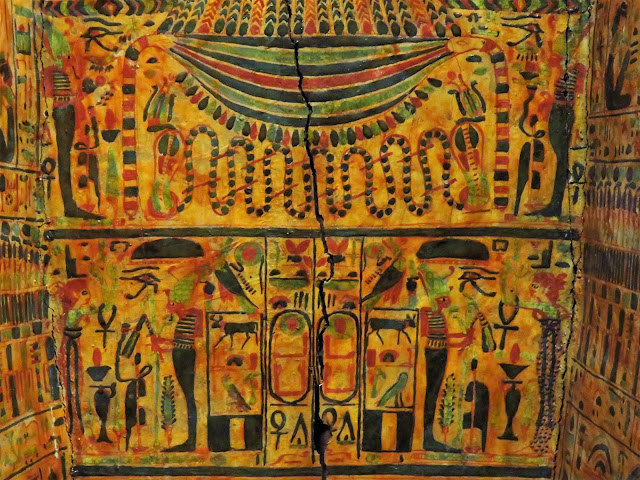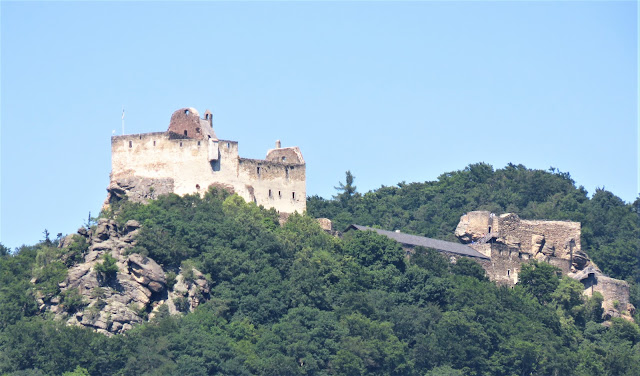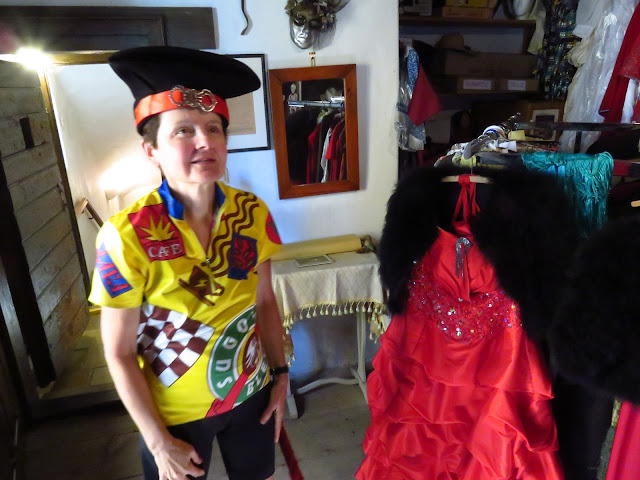We had originally planned on three nights in Vienna but got 2 days ahead of our tentative schedule so extended that to five nights. There was plenty to see, and there's plenty more should we find the opportunity to return.
Our first day took us to Schönbrunn Palace and its extensive grounds. The Palace was intended by the Habsburgs to one day rival Versailles, but they never had quite as much money, or perhaps the same ability to squeeze their subjects dry, as the Bourbon dynasty possessed. Nonetheless, it is indeed an enormous and impressive place. Unlike most tourists who come in the front way and BAM, there it is in all its enormity, we did a walk through the adjacent neighborhood and then arrived from the back of the palace's park and watched the palace get closer and closer, until you finally comprehended just how large it was when people stopped being mere dots in the distance. We did go in and take the tour, but no photos allowed. It was, rest assured, quite elegant.
 The next day the agenda was a walk in the heart of town, past a variety of places such as St. Stephen's Cathedral, which is mid-way through a much-needed steam cleaning of its beautiful stonework exterior. On a quiet alley nearby was the Mozart House, actually one of many places he lived in while in Vienna. It's allegedly the one he was happiest in, and the one where he composed The Marriage of Figaro. There is a wonderful statue of Mozart we put in our blog in May 2013 when we last visited Vienna, so this time we instead checked out the statues of two other musicians intimately connected with the city, Johann Strauss Jr. and Ludvig van Beethoven.
The next day the agenda was a walk in the heart of town, past a variety of places such as St. Stephen's Cathedral, which is mid-way through a much-needed steam cleaning of its beautiful stonework exterior. On a quiet alley nearby was the Mozart House, actually one of many places he lived in while in Vienna. It's allegedly the one he was happiest in, and the one where he composed The Marriage of Figaro. There is a wonderful statue of Mozart we put in our blog in May 2013 when we last visited Vienna, so this time we instead checked out the statues of two other musicians intimately connected with the city, Johann Strauss Jr. and Ludvig van Beethoven.We dropped into the Jesuit Church to admire its ornate interior. But what you see is not necessarily what you actually see. Those marvelous marble columns? They're painted stone.
Look up at that magnificent dome while standing a few rows from the back. Not likely you'll turn around to look at it again when you get to the front of the church, but if you were to do so, you'd see that it looks quite odd. That's because it's not a dome at all, but a trompe l'oeil ('fool the eye') illusion of a dome that has been painted on a simple cylindrical ceiling, and meant to be glanced at only as one enters the church.
 Quite the opposite approach motivated Otto Wagner when he designed the Postal Savings Bank in 1904, just a block away. What you saw was exactly what you got, including unadorned light bulb holders hanging out from metal posts, and metallic air vents throughout the lobby. The term HVAC hadn't been invented yet, but Mr. Wagner was way ahead of his time on the HV part of it. Also note how light-filled the lobby was, and how the glass tiles in the floor brought that wealth of light to the floor below. Quite an interesting building.
Quite the opposite approach motivated Otto Wagner when he designed the Postal Savings Bank in 1904, just a block away. What you saw was exactly what you got, including unadorned light bulb holders hanging out from metal posts, and metallic air vents throughout the lobby. The term HVAC hadn't been invented yet, but Mr. Wagner was way ahead of his time on the HV part of it. Also note how light-filled the lobby was, and how the glass tiles in the floor brought that wealth of light to the floor below. Quite an interesting building.Finally, as we walked the great city the Austrians call Wien, we of course had to have a lunch of Wieners. Served Austrian style -- you pick them up with your fingers and dip them in mustard. If that seems a little odd to American sensibilities, is it any less odd to pick one up with your fingers when it's encased in a (generally tasteless) bun? And what about that bun sitting next to these Wieners? Well it's meant to be eaten, for sure, but I doubt you'll ever get your Wieners to fit inside of one. You just munch on it from time to time.
 Our final major destination was the Kunsthistorisches Museum, filled with items from antiquity through the Old Masters. The Egyptian collection was especially impressive. The collection of mummies and mummy cases was one of the largest we've seen, and included all sorts of styles from the simplest to the most complex. The sacred Ibis was quite elegant, and the papyrus scroll pretty amazing. It's from about 200 BC, and gives elaborate instructions on how to properly mummify a sacred ox. Now that's the sort of recipe you want to be sure not to misplace!
Our final major destination was the Kunsthistorisches Museum, filled with items from antiquity through the Old Masters. The Egyptian collection was especially impressive. The collection of mummies and mummy cases was one of the largest we've seen, and included all sorts of styles from the simplest to the most complex. The sacred Ibis was quite elegant, and the papyrus scroll pretty amazing. It's from about 200 BC, and gives elaborate instructions on how to properly mummify a sacred ox. Now that's the sort of recipe you want to be sure not to misplace!
In a category of its own was this model of a gold and silver mine created by Slovakian miners and presented to the Emperor in 1764. It illustrates the use of an early type of steam engine to pump water out of the mine.
The building was also one of a kind. At times it rivaled the artwork within. And in the largest atrium, at the top of the stairs, the building and artwork became one in the form of mural paintings by Gustav Klimt.
The collection did not include our favorite period, the late 19th century, so we settled for our second-favorite, the Dutch Masters, plus one special painting by the Italian Canaletto that showed Schönbrunn Palace as it appeared in circa 1760, when it was considered to be well out in the country (it's now only a few stops from the heart of town on the U4 subway line).
As for the Dutch Masters, there was no shortage of interesting works. For example, here are two very different ones by Pieter Breugel the Elder, the first a peasant dance and the second an almost encyclopedic depiction by 230 children of 83 different children's games from the 1560s.
 Yet another work by this remarkable painter has to be looked at very, very closely to fully appreciate his craftsmanship. This is one of several iterations he painted of the Tower of Babel. Just look at the detailed view we get of late medieval construction techniques! If you look closely at that black wheel, there are two workmen inside walking like gerbils in a gerbil wheel, working to lift the stone that is suspended below the device. Keep in mind too that the painting is large but not enormous, and the odds are high that these close-ups are way larger on your computer screen than they are in the painting itself.
Yet another work by this remarkable painter has to be looked at very, very closely to fully appreciate his craftsmanship. This is one of several iterations he painted of the Tower of Babel. Just look at the detailed view we get of late medieval construction techniques! If you look closely at that black wheel, there are two workmen inside walking like gerbils in a gerbil wheel, working to lift the stone that is suspended below the device. Keep in mind too that the painting is large but not enormous, and the odds are high that these close-ups are way larger on your computer screen than they are in the painting itself.The museum is also the owner of one of the only 39 paintings known to exist by Johannes Vermeer, every one of them a priceless masterpiece for their ability to capture a moment and to render it in perfect three-dimensional perspective. The is one of the more well-known ones, The Art of Painting.
Finally, with a trip to England coming up, we were drawn to this portrait of Katherine of Aragon by a little-known Estonian artist, Michiel Sittow, and to another of Jane Seymour by the well-known German who became court painter to Henry VIII, Hans Holbein the Younger.
 It was now time to move on, this time by train. We rode our tandem about a kilometer to the Hauptbahnhof Wien, where there were thankfully elevators that were long enough for our tandem to fit without taking off the panniers and holding the front up in the air (as we had to do to get to and from the two trains we took a week earlier). Actually getting the bike to fit in the bike area on the train was another matter. It was clearly not designed with tandems in mind. Since we could not stand our bike up vertically, we used a bungee cord to hold it upright across the aisle. Luckily this was the front of the front car on the train, so passengers were able to avoid this unfortunate tight spot by using the back door of the car. Luckily too, we took the train to its last stop so did not have a frantic rush getting the bike off at the end.
It was now time to move on, this time by train. We rode our tandem about a kilometer to the Hauptbahnhof Wien, where there were thankfully elevators that were long enough for our tandem to fit without taking off the panniers and holding the front up in the air (as we had to do to get to and from the two trains we took a week earlier). Actually getting the bike to fit in the bike area on the train was another matter. It was clearly not designed with tandems in mind. Since we could not stand our bike up vertically, we used a bungee cord to hold it upright across the aisle. Luckily this was the front of the front car on the train, so passengers were able to avoid this unfortunate tight spot by using the back door of the car. Luckily too, we took the train to its last stop so did not have a frantic rush getting the bike off at the end.Our trip took us pretty much the length of Austria, from Vienna (Wien) to Feldkirch, which is the unnamed stop on the map between Innsbruck and Zurich. It is only a few kilometers from there into either Switzerland or Liechtenstein, both of which were on our agenda.
The scenery along the way was spectacular. Here are a few shots of the Inn River and its valley, on the way to Innsbruck, then of the equally impressive mountains in Voralberg Province, the westernmost part of Austria adjacent to Switzerland.
There may have been a time we could have biked through an area like this, but boy, that train has left the station! We were very happy indeed that Feldkirch is in a fairly flat area close to the Rhine.
Feldkirch was also a great choice of where to hop off. The town itself is largely off the tourist grid but attractive in a low-key way, complete with a decent town square, a local castle that is seemingly still lived in given the flowerboxes, and a chilly glacial river racing through town with a velocity that is simply not capturable with only a still photograph.
The best thing about Feldkirch, however, was that it was only a hop, skip and jump from there to Liechtenstein. There are no guidebooks on how to do this, but OpenCycleMap.org has terrific maps of all Europe showing national, regional and local bike routes. Jeff printed off a few pages at home last month by taking screen shots on the computer and pasting them into a printable Word document, and the route out of Feldkirch turned out to be easy to follow and fun to ride. In less than 20 km we had crossed into Liechtenstein and made it to the capital city of Vaduz. Of course, if you cross into Liechtenstein anywhere within the country, you have almost made it to the capital city of Vaduz. At 160 sq. km., Liechtenstein is about the size of Brooklyn NY with a few blocks removed. Oh, yes, and with a mountain rising up about 7,200 feet, or six Empire State Buildings, in the middle.
We pedaled up a low rise, not even in our lowest grear, rounded a bend, and then Whoa! Yeah, Switzerland and Liechtenstein will do that to you. All the rest of the way into Vaduz we were on flat roads admiring unflat landscape all around us.
Then, less than 20 easy km from Feldkirch, we stopped the bike for a photo. We were within a km of "downtown" Vaduz, and high above us was Schloss Vaduz, home of Hans-Adam II, the current Prince of Liechtenstein. In the heart of Vaduz we stopped to take one other photo in front of an impressive government building, and there's Schloss Vaduz again, way up on the mountain above town. Now that is one impressive location!
Liechtenstein is on the upper Rhine River, and in our next blog we'll head down the Rhine to Lake Constance, aka the Bodensee, and then ride almost 360 degrees around it.



































































































